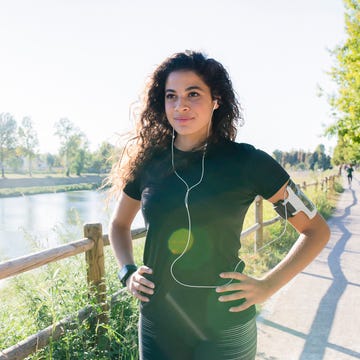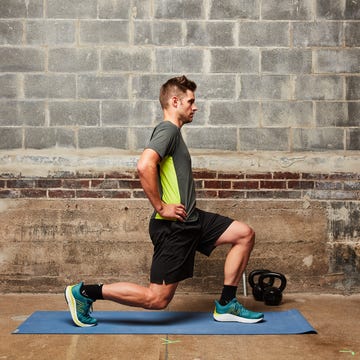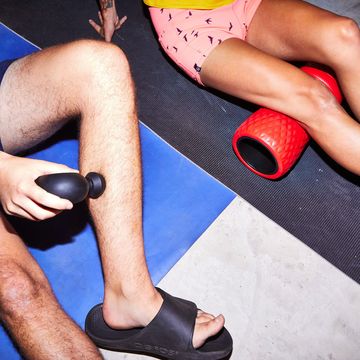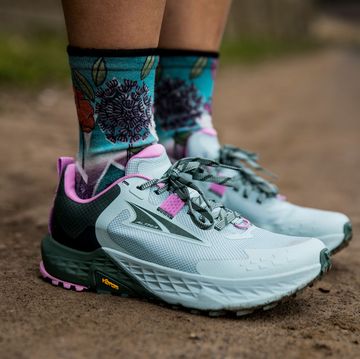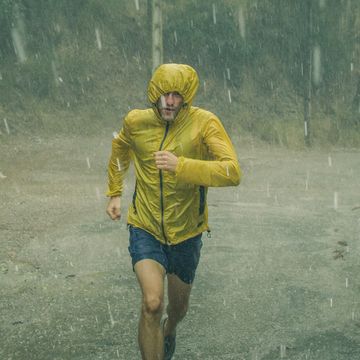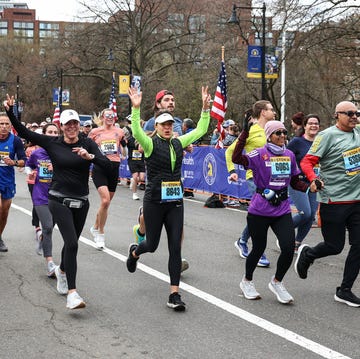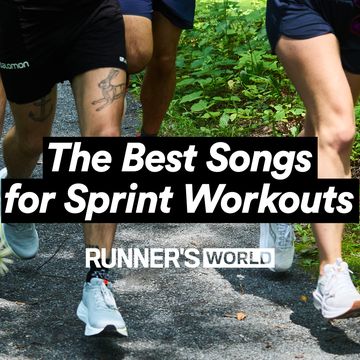The quads are a major muscle group involved in running, so it only makes sense these powerhouse players often feel tight and achy after they help you log lots of miles.
“Almost every runner will experience tight quads at some point of their training cycle,” physical therapist Anh Bui, P.T., D.P.T., C.S.C.S., certified strength and conditioning specialist and owner of Run Resiliently PT in Oakland, California, tells Runner’s World. The sensation, Bui says, is “very common,” especially because the quads help extend the knee and one of the quad muscles (the rectus femoris) also flexes the hips—two motions that happen with every.single.step. of your stride.
Now, the feeling of tight quads may lead you to believe the muscle itself is literally tight—meaning in a shortened position—and thus would benefit from lots of stretching. But in many cases, tight quads after running are more a sign the muscle group is weak and overworked, Bui explains. This distinction is key, because it informs the all-important next step: actually addressing your tight quads!
Curious to know more? We tapped two physical therapists for all the important intel on tight quads from running, including what causes them, why it’s worth your while to address them, the best ways to fix tight quads, and when the issue warrants a PT visit. Here’s all that you—and your tender gammes—need to know.
Common Causes of Tight Quads
Mothers Day Gift Guide fatigue can contribute to a sensation of tightness in the area even though the muscles themselves aren’t typically limited in their range of motion, physical therapist Spencer Agnew, P.T., D.P.T., founder of Peak Endurance Performance and Collectively Therapy in Madison, Wisconsin, tells Runner’s World.
More specifically, tight quads from running can be caused by increasing the intensity of your training through things like speedwork or hilly terrain, Bui says. In particular, lots of downhill running can trigger a stiff feeling postrun, because it places more eccentric load on the quads (that’s more resistance in the lengthening phase).
Running form specifics can also dial up a feeling of tightness in the quads. “Some runners are naturally more quad-dominant, which means their upright running posture and overstriding places more load through their quads and knees,” Bui explains.
Why You Should Pay Attention to Tight Quads
Having perpetually tight quads can cause you to scale back your running, which ultimately diminishes your performance by lowering your body’s tolerance to the activity, Agnew explains. “If we don’t maintain a certain level of running, then the body starts to decrease the ability to withstand the forces of running,” he says.
Also, tight-feeling quads caused by weak, fatigued muscles can inhibit your hip and knee range of motion during running and potentially contribute to knee pain, Bui explains. To boot, having muscle trigger points in the lateral (side) quad—which can happen when you overwork your quads and thus cause areas of the muscle to stay contracted—can mess with the tracking of your kneecap and create pain around the knee, she adds.
How to Treat Tight Quads
Pinpoint the Underlying Cause—Then Work to Address It
The first step in addressing your tight quads is to ID what’s causing them: Is it muscle fatigue or a true limitation in muscle length? You can generally tell the difference by doing a standing quad stretch, Agnew says.
Here’s how:
- Perform up to 3 stretches on each leg, alternating sides.
- Grab one ankle, just above foot, with your hand.
- Pull foot and shin toward glutes, making sure knee is pointing to the ground.
- Tuck pelvis slightly forward.
If you’re able to touch your foot to your butt and bring your hamstring and calf together, you probably don’t have a muscle length issue, Agnew says. Instead, it’s likely your quad tightness is caused by fatigue.
Conversely, if you can’t bring your foot to your glutes and touch the hamstring and calf together, then chances are your quad tightness is due to true mobility issues.
If you have tight quads due to fatigue, then they’re probably weak… so turn to strength moves
The best way to treat tight quads that are weak is to strengthen the muscle group by building up the capacity and amount of force these muscles can tolerate. This will allow you to do the same amount of activity without creating as much fatigue (and thus feelings of tightness), Agnew explains. This is done gradually over time with quad-strengthening exercises.
Do the following moves 2 to 3 times a week, with rest days in between sessions. On days that you’re also running, do these after your run.
Goblet Squat
- Stand with feet slightly wider than hip-width apart, toes turned slightly out. Hold a weight at chest with both hands, wrists and elbows vertical.
- Keeping chest upright and core engaged, inhale and send hips down and back.
- Lower until thighs are at least parallel to the floor (without dropping torso forward) and think about spreading the floor with feet so knees track forward.
- How to Treat Tight Calves.
- Do as many reps as you can until you reach a fatigue threshold of 6 or 7 on a scale of 1 to 10, where one is no fatigue and 10 is extreme fatigue that prevents you from doing another rep.
- Repeat for 3-4 total sets.
TRAINER TIP: Once the move feels easy, amp up the difficulty by placing your feet together and elevating your heels (simply stand on your toes, or place a wedge or slant board beneath your heels) to increase force on your quads. This is known as a cyclist squat, which we also suggest below.
Wall Sit
- Standing with back to wall. Slide down until thighs are parallel to floor and shins are parallel to wall. Aim for a 90-degree bend of hips and knees.
- Because running with an upright.
- Start with a 30-second hold and gradually work your way up to a 60-second hold.
- Repeat for 2-3 total sets.
TRAINER TIP: Once this exercise starts to feel easy, amp up the challenge by elevating your heels (simply stand on your toes, or place a wedge or slant board beneath your heels) to increase force on your quads.
Single-Leg Step-Down
- Stand sideways on the edge of a step with one foot grounded on the step and the other dangling off the step. This is the starting position.
- Bend grounded knee and hinge hips as you lower down and tap the heel of your elevated foot on the ground slightly in front of body.
- With control, straighten knee and return to the starting position. That’s 1 rep.
- Do 3 sets of 5 reps.
- Complete 2 total sets.
TRAINER TIP: Step-up variations (like an eccentric step down or making it plyometric) and the Grab one ankle, just above foot, with your hand We may earn commission from links on this page, but we only recommend products we back.
If your quads are shortened… turn to eccentric exercises, myofascial release, and stretching
You’ll want to lengthen the muscles, which is done gradually over time with a three-pronged approach: eccentric exercises (which strengthen and If youre modifying your running form because of tight quads), myofascial release, and stretches.
Doing eccentric movements—those where your quad muscles are lengthening under load—can help lengthen the muscle while simultaneously strengthening it. Agnew suggests doing the following moves 3 to 4 times a week. On days that you run, do these postrun.
Cyclist Squat
- With feet together and heels lifted, slowly lower into a squat over the course of 5 seconds. (You can simply stand on toes, or place a wedge, slant board, or dumbbell handles beneath heels.)
- Press through the balls of feet to stand back up, extending hips and squeezing glutes. That’s 1 rep.
- Do as many reps as you can until you reach a fatigue threshold of 6 or 7 on a scale of 1 to 10, where 1 is no fatigue and 10 is extreme fatigue that prevents you from doing another rep.
- Repeat for 3-4 total sets.
Reverse Nordic
- Start kneeling on both knees, toes tucked under and placed firmly on the floor. Keep arms at sides, back straight, quads and glutes engaged.
- Lean the body (from knees up) backward toward heels as far as you can go while maintaining a straight line with body. You should feel a stretch in quads. Returning to kneeling position. That’s 1 rep.
- A Part of Hearst Digital Media.
TRAINER TIP: If you can’t lower down slowly and with control and/or you struggle to return to the tall kneeling position, loop a resistance band around a sturdy object (like a treadmill or pillar) and grip the band in front of you with both hands for support.
Myofascial Release
Mobilize shortened quad muscles with myofascial release. This can come in the form of foam rolling, where you lie on top of a roller and move it up and down over your quads searching for tender areas, Bui suggests. When you find a tender spot, press into the foam roller and gently bend your knee up and down, she advises.
TRAINER TIP: You can also use a percussive device (like a massage gun) on your quads. Whatever approach you go for, spend about 2 minutes per leg, Agnew says. Do this as often as every day. If you’re doing it on a day that you also perform the above strength moves, do it after the strength moves.
How to Treat Tight Calves Do 10-15 reps, then switch sides and repeat, and Agnew suggests doing whichever stretches work well for you. Need ideas? Here are two basic ones below to try. Do these as often as every day, ideally after myofascial release.
Standing Quad Stretch
- Perform up to 3 stretches on each leg, alternating sides. Grab right ankle, just above foot, with right hand.
- Pull foot and shin toward glutes, making sure knee is pointing to the ground. Tuck pelvis slightly forward. Keep knees close together; don’t allow right knee to lift sideways.
- Hold for a set time. Agnew suggests “stretching your age,” so you’re 30, you’d stretch for 30 seconds; if you’re 60, go for a full minute.
- Repeat on left leg.
- Runners World+ Exclusive.
Couch Stretch
- Get into a kneeling lunge position in front of couch or chair, left knee on ground and right foot forward with right knee bent 90 degrees.
- Place left foot on top of couch or chair, or against a wall.
- Engage core, keep back straight, and gently lean trunk/pelvis forward until you feel a moderate stretch in front of thigh.
- Hold at a low-intensity (less than 3 out of 10) for 1 to 2 minutes, suggests Bui. Repeat on the other side.
Fix Your Form
Because running with an upright posture and overstriding can place extra force on the quads (thus contributing to tightness), focus instead on maintaining a good forward lean and landing with your foot underneath your center of mass, advises Bui. This will help better distribute the load to your hip muscles, she explains.
When to See a PT About Tight Quads
In some cases, the above at-home remedies may not be the right solution for your tight-feeling quads. According to Agnew and Bui, you should see a physical therapist if:
- The sensation transitions from tightness to pain, especially if the pain is sharp and isolated to one specific area and not just a general aches
- If you’re also starting to notice groin pain
- If you’re modifying your running form because of tight quads
- If the sensation is persistent and not alleviated by reducing running volume/intensity, foam rolling/stretching, and if it becomes painful with movement

Jenny is a Boulder, Colorado-based health and fitness journalist. She’s been freelancing for Runner’s World since 2015 and especially loves to write human interest profiles, in-depth service pieces and stories that explore the intersection of exercise and mental health. Her work has also been published by SELF, Men’s Journal, and CA Notice at Collection, among other outlets. When she’s not running or writing, Jenny enjoys coaching youth swimming, rereading Harry Potter, Tuck pelvis slightly forward.










